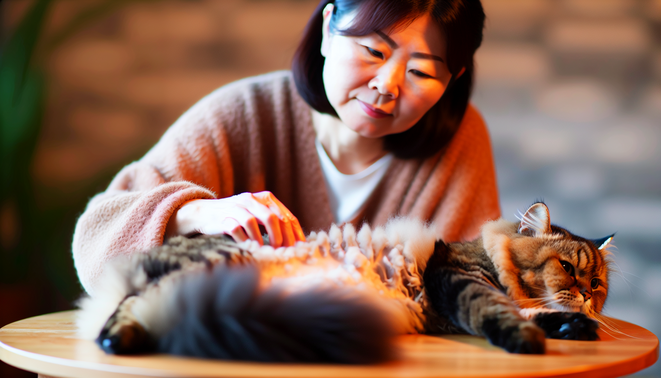“`html
Understanding the Subtle Signals: What Your Cat is Trying to Tell You
Cats are known for their unique ways of communicating, utilizing body language, vocalizations, and subtle behaviors to express their feelings and needs. For instance, slow blinking is a sign of trust; you can reciprocate this gesture to deepen your bond. Conversely, a cat’s twitching tail or flattened ears can signal discomfort or agitation. It’s essential to recognize these signals promptly to foster trust and connection. To enhance your understanding of your furry companions, check our guide on introducing new pets.
The Art of Cat Petting: Techniques to Enhance Connection
During petting sessions, the manner in which you engage with your cat can greatly influence your relationship. Always be attentive to your pet’s reactions to your touch; some cats enjoy gentle strokes along their back, while others may prefer chin scratches. Establishing a comfortable dynamic where your cat feels safe can enhance emotional intimacy. Just sitting quietly near your relaxed cat can promote a nurturing environment, encouraging them to trust you more. To learn additional ways of creating a comfortable home for your cat, visit our article on furniture solutions.
The Body Language Breakdown: Key Signs of Enjoyment and Discomfort
Being attuned to your cat’s body language can help you understand their emotional state better. Signs of enjoyment include a relaxed posture, purring, and kneading. In contrast, discomfort can manifest through tail flicking, hissing, or ears turned back. Learning these signals not only improves your interactions but also strengthens the bond you share with your feline friend.
Creating a Safe Space: How Environment Affects Cat Behavior
The environment you create for your cat significantly impacts their behavior and well-being. A quiet, secure space equipped with cozy hideaways can help your cat feel safe and more inclined to explore and play. Interactive toys and safe places to climb can satisfy their instincts and promote positive interactions. Engaging with your cat in their favorite areas can deepen your connection and facilitate enjoyable experiences.
Responding to Your Cat’s Cues: Building Trust Through Empathy
Understanding and responding to your cat’s cues is vital for fortifying your bond. For example, when your cat signals hunger or seeks play, responding positively reinforces their feelings of safety and affection. The key lies in empathy; it may require practice to fully understand your cat’s unique personality. By regularly observing your cat and catering to their needs, you create a nurturing environment that fosters loving connections.
Common Misconceptions About Cat Behavior and Body Language
Many misunderstandings about cat behavior can impede our ability to connect with them effectively. Here are some prevalent myths debunked:
- Myth: Cats Purr Only When They Are Happy – Cats purr in various emotional states, including fear or pain; it is a self-soothing mechanism [Source: Cat Behavior Associates].
- Myth: A Flicking Tail Indicates a Happy Cat – A flicking tail usually suggests agitation. Observing the context helps interpret the meaning of the movement [Source: The Spruce Pets].
- Myth: Cats Only Meow to Communicate with Humans – Cats vocalize with other cats too, showcasing different communication methods between species [Source: Catster].
- Myth: Cats Are Solitary Animals – While independent, cats can form strong social bonds with humans and other pets [Source: DVM360].
- Myth: Scratching Is a Sign of Anger or Aggression – Scratching is a natural behavior; providing appropriate scratching posts can mitigate unwanted behavior [Source: Humane Society].
Understanding these misconceptions can enhance your relationship and interactions with your feline companions. For more insights into cat care, consider reading our article on litter box solutions.
Sources
- Cat Behavior Associates – Why Do Cats Purr?
- Catster – Understanding Cat Communication
- DVM360 – Cat Relationships: A Guide to Feline Social Interaction
- Humane Society – Why Cats Scratch
- The Spruce Pets – Understanding Cat Body Language
“`

1 thought on “Decoding Your Cat’s Body Language: The Silent Messages During Petting”